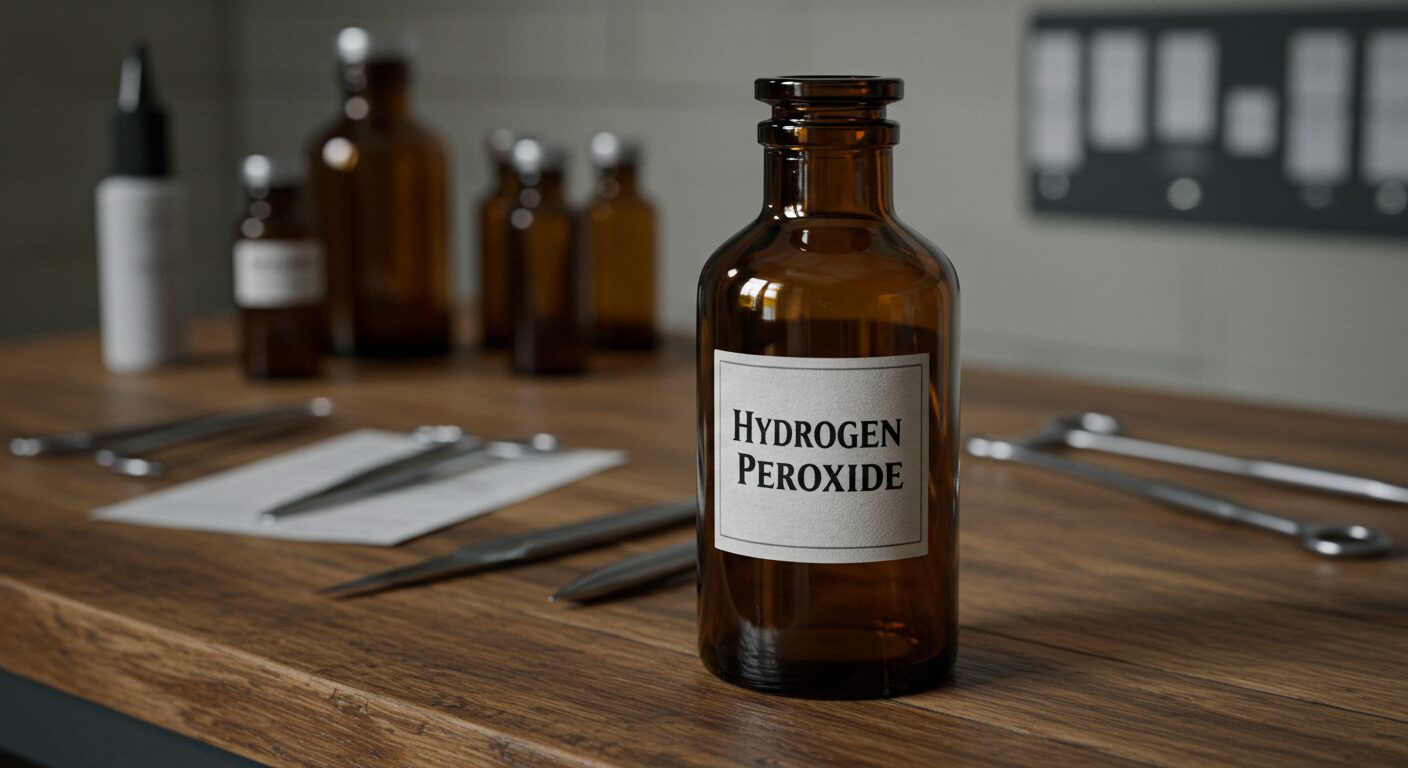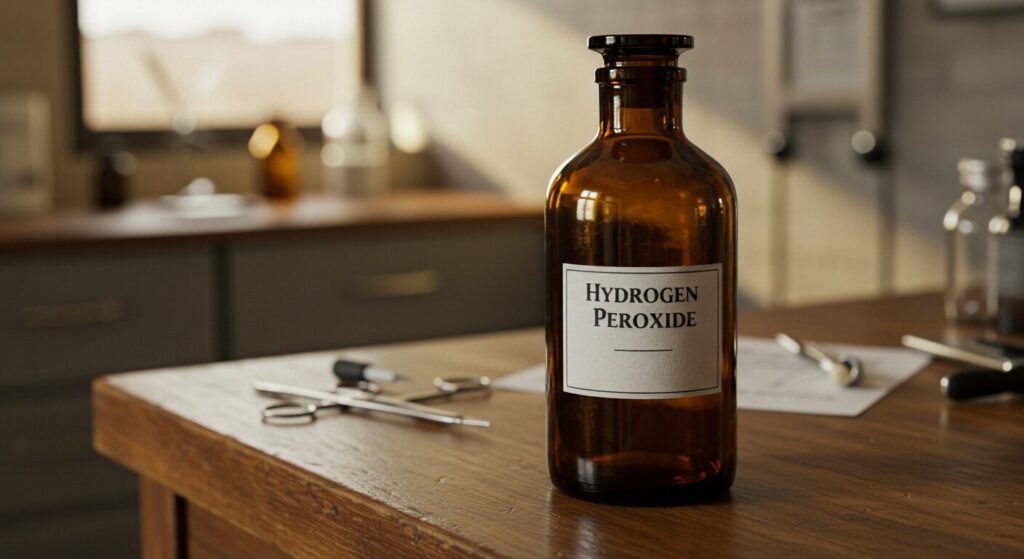Earwax buildup can be a frustrating and uncomfortable experience. While there are various methods for removing earwax, some people turn to hydrogen peroxide as a solution.
While hydrogen peroxide may seem like a convenient solution for earwax removal, the safety of hydrogen peroxide in ears is a topic of debate. But is using hydrogen peroxide in the ear safe for earwax removal?
Some experts argue that using hydrogen peroxide in the ear can be safe if done properly, while others warn against its use due to potential risks. In this article, we’ll explore the risks of using hydrogen peroxide in ears, alternatives to hydrogen peroxide, and expert advice.
What is Hydrogen Peroxide?
Hydrogen peroxide is a common household chemical used for various purposes, including cleaning wounds, whitening teeth, and removing earwax. It’s a strong oxidizing agent that can help break down and dissolve earwax.
Risks Associated with Using Hydrogen Peroxide in the Ear
Using hydrogen peroxide in the ear can lead to several complications, including:
1. Ear Canal Irritation: Hydrogen peroxide can irritate the ear canal, leading to itching, redness, and discomfort. This irritation can be severe and may require medical attention.
2. Eardrum Damage: If hydrogen peroxide comes into contact with the eardrum, it can cause damage, leading to hearing loss or tinnitus. The eardrum is a delicate structure, and any damage to it can have serious consequences.
3. Ear Infections: Using hydrogen peroxide in the ear can push earwax further into the ear canal, potentially causing ear infections. Ear infections can be painful and may require antibiotics or other treatments.
4. Allergic Reactions: Some people may be allergic to hydrogen peroxide, which can cause an allergic reaction when used in the ear. Symptoms of an allergic reaction may include itching, swelling, and difficulty breathing.
5. Earwax Impaction: Using hydrogen peroxide in the ear can cause earwax to become impacted, leading to hearing loss, ear pain, and other complications. Impacted earwax can be difficult to remove and may require medical attention.
6. Middle Ear Damage: Hydrogen peroxide can damage the middle ear, leading to hearing loss, vertigo, and other complications. The middle ear is a delicate structure, and any damage to it can have serious consequences.
7. Tinnitus: Using hydrogen peroxide in the ear can cause tinnitus, a condition characterized by ringing or other sounds in the ear. Tinnitus can be persistent and may require medical attention.
8. Ear Odor: Hydrogen peroxide can cause a strong, unpleasant odor in the ear, which can be embarrassing and uncomfortable.
9. Discomfort and Pain: Using hydrogen peroxide in the ear can cause discomfort and pain, especially if the ear canal is irritated or infected.
10. Long-term Hearing Damage: Repeatedly using hydrogen peroxide in the ear can cause long-term hearing damage, including permanent hearing loss. This is because hydrogen peroxide can damage the delicate structures of the ear, leading to hearing loss and other complications.
11. Infection of the Outer Ear: Hydrogen peroxide can cause an outer ear infection, known as otitis externa. This infection can be painful and may require antibiotics or other treatments.
12. Damage to the Ear Canal Skin: Hydrogen peroxide can damage the skin of the ear canal, leading to dryness, itching, and discomfort. This damage can be persistent and may require medical attention.
It is essential to note that these risks can be avoided by using alternative methods for earwax removal, such as ear drops or ear irrigation kits. If you’re experiencing earwax buildup or other ear-related issues, it is best to consult a healthcare professional for safe and effective treatment.
Hydrogen Peroxide in Ear: 7 Experts’ Advice
According to ear, nose, and throat (ENT) specialists, here are some tips for safe and effective earwax removal:
1. Avoid Using Hydrogen Peroxide
ENT specialists advise against using hydrogen peroxide in the ear, as it can cause damage to the ear canal and eardrum. Instead, they recommend using ear drops or ear irrigation kits specifically designed for earwax removal. These products are gentler on the ear canal and less likely to cause complications.
2. Don’t Use Cotton Swabs (Q-tips)
ENT specialists also recommend avoiding the use of cotton swabs (Q-tips) to remove earwax, as this can push the wax further into the ear canal and potentially cause damage to the eardrum. Instead, they recommend using ear drops or ear irrigation kits to safely remove earwax.
3. Avoid Using Household Items
ENT specialists advise against using other household items, such as bobby pins or hairpins, to remove earwax. These items can cause damage to the ear canal and eardrum, and can also push the wax further into the ear canal.
4. Consult a Healthcare Professional
If you’re experiencing earwax buildup or discomfort, ENT specialists recommend consulting a healthcare professional for safe and effective earwax removal. They can use specialized equipment and techniques to remove earwax and provide relief.
5. Get Regular Ear Check-Ups
ENT specialists recommend getting regular ear check-ups to prevent earwax buildup and detect any potential ear problems early. Regular ear check-ups can help to prevent complications and maintain good ear health.
6. Use Ear Drops or Ear Irrigation Kits Correctly
ENT specialists advise using ear drops or ear irrigation kits correctly to avoid causing damage to the ear canal or eardrum. Always follow the instructions carefully and consult with a healthcare professional if you have any questions or concerns.
7. Be Aware of Underlying Medical Conditions
ENT specialists recommend being aware of any underlying medical conditions that may affect earwax buildup, such as eczema or psoriasis. In these cases, regular ear cleaning and maintenance may be necessary to prevent earwax buildup.
Alternatives to Hydrogen Peroxide for Earwax Removal
If you’re looking for safer and more effective alternatives to hydrogen peroxide for earwax removal, here are some options to consider:
1. Ear Drops: Over-the-counter ear drops, such as Debrox or Earwax Removal Drops, can help dissolve and remove earwax. These drops typically contain ingredients like carbamide peroxide or hydrogen peroxide-free alternatives.
2. Ear Irrigation Kits: Ear irrigation kits, like Ear Syringes or Ear Irrigators, use a gentle stream of water to remove earwax. These kits are designed to be safe and effective and can be used at home.
3. Cerumol Ear Drops: Cerumol ear drops are a type of ear drop that helps to dissolve and remove earwax. They are available over the counter and are a popular alternative to hydrogen peroxide.
4. Earwax Removal Sprays: Earwax removal sprays, like Earwax Removal Spray or Wax-B-Gone, can help dissolve and remove earwax. These sprays typically contain ingredients like oils or waxes that help to break down earwax.
5. Warm Compresses: Applying a warm compress to the affected ear can help to loosen and remove earwax. This method is gentle and non-invasive and can be done at home.
6. Ear Vacuums: Ear vacuums, like Ear Vac or Ear Cleaner, use a gentle suction to remove earwax. These devices are designed to be safe and effective and can be used at home.
7. Professional Earwax Removal: If you’re experiencing persistent earwax buildup or discomfort, it’s best to consult a healthcare professional for safe and effective earwax removal. They can use specialized equipment and techniques to remove earwax and provide relief.
Remember to always follow the instructions carefully and consult with a healthcare professional if you have any concerns or questions about earwax removal.
Does hydrogen peroxide expire?
Yes, hydrogen peroxide can expire. Hydrogen peroxide is an unstable compound that breaks down over time, especially when exposed to light, heat, or contaminants. This breakdown can cause the hydrogen peroxide to lose its potency and effectiveness.
The expiration date of hydrogen peroxide depends on several factors, including:
1. Concentration: Hydrogen peroxide solutions with higher concentrations (e.g., 35% or 50%) tend to be more stable and have a longer shelf life than those with lower concentrations (e.g., 3% or 6%).
2. Storage conditions: Hydrogen peroxide should be stored in a cool, dark place, away from heat sources and direct sunlight. Exposure to heat, light, or moisture can cause the hydrogen peroxide to break down more quickly.
3. Packaging: Hydrogen peroxide solutions in dark glass bottles or containers with tight-fitting lids tend to be more stable and have a longer shelf life than those in clear plastic bottles or containers.
4. Manufacturer’s recommendations: Check the manufacturer’s label or instructions for any specific recommendations on storage, handling, and expiration dates.
Typically, hydrogen peroxide solutions have a shelf life of:
- 3% hydrogen peroxide: 1-2 years
- 6% hydrogen peroxide: 2-3 years
- 35% hydrogen peroxide: 3-5 years
- 50% hydrogen peroxide: 5-7 years
It’s essential to note that even if hydrogen peroxide has not expired, it may still lose its potency and effectiveness over time. If you’re unsure about the stability or effectiveness of your hydrogen peroxide solution, it’s best to err on the side of caution and discard it.
Conclusion
While hydrogen peroxide may seem like a convenient solution for earwax removal, its use in the ear is not recommended due to potential risks and complications. Instead, opt for safer and more effective alternatives, such as ear drops or ear irrigation kits.
If you’re experiencing persistent earwax buildup, consult a healthcare professional for safe and effective removal. At Clinicaid.com.ng, we offer a range of earwax removal products that are safe and effective. Visit our website today to explore our range of earwax removal products and take the first step towards safe and effective earwax removal.

Digi Clinicaid Nigeria Ltd is an online medical marketplace in Nigeria.









